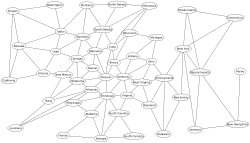Graphviz
 | |
| Developer(s) | AT&T Labs Research and contributors[1] |
|---|---|
| Initial release | before 1991[2] |
| Stable release |
2.40.1
/ 25 December 2016[3] |
| Repository |
github |
| Written in | C |
| Operating system | Linux, macOS, Windows |
| Type | Graph visualization |
| License | Eclipse Public License |
| Website |
graphviz |

A Red-Black Tree plotted by Graphviz.

Undirected graph showing adjacency of the 48 contiguous United States
Graphviz (short for Graph Visualization Software) is a package of open-source tools initiated by AT&T Labs Research for drawing graphs specified in DOT language scripts. It also provides libraries for software applications to use the tools. Graphviz is free software licensed under the Eclipse Public License.
Software architecture
Graphviz consists of a graph description language named the DOT language[4] and a set of tools that can generate and/or process DOT files:
- dot
- a command-line tool to produce layered drawings of directed graphs in a variety of output formats (PostScript, PDF, SVG, annotated text and so on).
- neato
- for "spring model" layout (in Mac OS version called "energy minimised")
- sfdp
- a layout engine for undirected graphs that scales to very large graphs.
- fdp
- another layout engine for undirected graphs.
- twopi
- for radial graph layouts.
- circo
- for circular graph layouts.
- dotty
- a graphical user interface to visualize and edit graphs.
- lefty
- a programmable (in a language inspired by EZ[5]) widget that displays DOT graphs and allows the user to perform actions on them with the mouse. Lefty can therefore be used as the view in a model-view-controller GUI application that uses graphs.
Applications that use Graphviz
- AsciiDoc can embed Graphviz syntax as a diagram.
- ArgoUML's alternative UML Diagram rendering called argouml-graphviz.
- Bison is able to output the grammar as dot for visualization of the language.
- ConnectedText has a Graphviz plugin.
- Doxygen uses Graphviz to generate diagrams including class hierarchies and collaboration for source code.
- Gephi has a Graphviz plugin.
- Gramps uses Graphviz to create family trees.
- Omnigraffle 5 uses the Graphviz engine for automatically laying out graphs.
- Org-mode can work with DOT source code blocks
- PlantUML uses Graphviz to generate UML diagrams from text descriptions.
- Puppet can produce DOT resource graphs which can be viewed with Graphviz.
- Scribus is an Open Source DTP program that can use Graphviz to render graphs by using its internal editor in a special frame type called render frame.
- Sphinx is a documentation generator that can use Graphviz to embed graphs in documents.
- Trac wiki has a Graphviz plugin.
- WikidPad uses Graphviz as a plugin.
- Zim includes a plugin that allows adding and editing in-page diagrams using the Graphviz dot language.
- TOra a free software database development and administration GUI, available under the GNU GPL.
See also
References
- ↑ "Credits Graphviz".
- ↑ Eleftherios Koutsofios and Stephen North. Drawing graphs with dot. Technical Report 910904-59113-08TM, AT&T Bell Laboratories, Murray Hill, NJ, September 1991.
- ↑ https://github.com/ellson/graphviz/releases/tag/stable_release_2.40.1
- ↑ The DOT Language
- ↑ The Lefty guide (“Editing Pictures with lefty”), section 3.1, p. 9.
External links
- Official website
- graphviz on GitHub
- Graphviz, Projects & Software Page, AT&T Labs Research
- An Introduction to Graphviz and dot (M. Simionato, 2004)
- Create relationship diagrams with Graphviz (Shashank Sharma, 2005)
- Use Graphviz in a web browser without downloading any software
- Webgraphviz, port of Graphviz for Javascript running on the browser
- Gravizo online graph image generator to embed directly on your page or readme. Can generate Graphviz, PlantUML and UMLGraph
This article is issued from
Wikipedia.
The text is licensed under Creative Commons - Attribution - Sharealike.
Additional terms may apply for the media files.